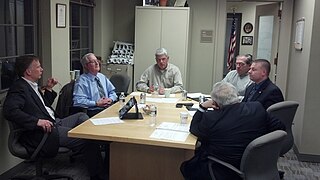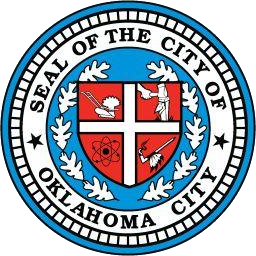Related Research Articles
In England, local authorities are required to adopt one of three types of executive arrangements, which govern how decisions will be made within the council. Before the passing of the Localism Act 2011 there were two principal modes of executive arrangements, namely the "leader and cabinet" and the "elected mayor and cabinet" models. A third option "elected mayor and council manager" was withdrawn in 2007. Since 2012, principal authorities have been allowed to adopt the "committee system" form of governance.
In many countries, a mayor is the highest-ranking official in a municipal government such as that of a city or a town. Worldwide, there is a wide variance in local laws and customs regarding the powers and responsibilities of a mayor as well as the means by which a mayor is elected or otherwise mandated. Depending on the system chosen, a mayor may be the chief executive officer of the municipal government, may simply chair a multi-member governing body with little or no independent power, or may play a solely ceremonial role. A mayor's duties and responsibilities may be to appoint and oversee municipal managers and employees, provide basic governmental services to constituents, and execute the laws and ordinances passed by a municipal governing body. Options for selection of a mayor include direct election by the public, or selection by an elected governing council or board.

Cache is a city in Comanche County, Oklahoma, United States. The population was 2,796 at the 2010 census. It is an exurb included in the Lawton, Oklahoma Metropolitan Statistical Area. It is the location of Star House, the home of the Comanche chief Quanah Parker, the major leader of the Quahadi Comanche in the years of Indian Wars and transition to reservation life.

Bethany is a city in Oklahoma County, Oklahoma, United States, and a part of the Oklahoma City metropolitan area. The community was founded in 1909 by followers of the Church of the Nazarene from Oklahoma City.

The Government of New York City, headquartered at New York City Hall in Lower Manhattan, is organized under the New York City Charter and provides for a mayor-council system. The mayor is elected to a four-year term and is responsible for the administration of city government. The New York City Council is a unicameral body consisting of 51 members, each elected from a geographic district, normally for four-year terms. All elected officials—other than those elected before 2010, who are limited to three consecutive terms—are subject to a two consecutive-term limit. The court system consists of two citywide courts and three statewide courts.

The board of selectmen or select board is commonly the executive arm of the government of New England towns in the United States. The board typically consists of three or five members, with or without staggered terms. Three is the most common number, historically.
The Calgary City Council is the legislative governing body that represents the citizens of Calgary. The council consists of 15 members: the chief elected official, titled the mayor, and 14 councillors. Jyoti Gondek was elected mayor in October 2021 as the city's 37th. Each of the 14 councillors represent one of the city's 14 wards.
The Optional Municipal Charter Law or Faulkner Act provides New Jersey municipalities with a variety of models of local government. This legislation is called the Faulkner Act in honor of the late Bayard H. Faulkner, former mayor of Montclair, New Jersey and chairman of the Commission on Municipal Government.
A municipal council is the legislative body of a municipality or local government area. Depending on the location and classification of the municipality it may be known as a city council,town council, town board, community council, rural council,village council, or board of aldermen.

The Mayor of the City of Richmond, Virginia is head of the executive branch of Richmond, Virginia's city government. The mayor's office administers all city services, public property, police and fire protection, most public agencies, and enforces all city, state and federal laws within Richmond, Virginia.

The government of the U.S. State of Oklahoma, established by the Oklahoma Constitution, is a republican democracy modeled after the federal government of the United States. The state government has three branches: the executive, legislative, and judicial. Through a system of separation of powers or "checks and balances," each of these branches has some authority to act on its own, some authority to regulate the other two branches, and has some of its own authority, in turn, regulated by the other branches.

Buffalo, New York's government is run by a democratically elected mayor and council of nine members.

The Government of Miami-Dade County is defined and authorized under the Constitution of Florida, Florida law, and the Home Rule Charter of Miami-Dade County.

The Government of Saginaw, Michigan is a council-manager form of government with a mayor selected from members of the city council by members of the city council. Saginaw is classified as a home rule city under the Michigan Home Rule Cities Act which permits cities to exercise "home rule" powers, among which is the power to frame and adopt its own city charter which serves as the fundamental law of the city, in a manner similar to a constitution for a national or state government. The present charter was adopted in 1935 and took effect on January 6, 1936.
The government of Indianapolis is a mayor-council, consolidated city-county system. The executive branch is headed by the elected mayor, and the legislative branch is made up of the 25-member City-County Council. Indianapolis and Marion County have a consolidated government known as Unigov. Most government offices are located in the City-County Building.
The mayor–council government system is a system of organization of local government that has an executive mayor who is elected by the voters, and a separately elected legislative city council. It is one of the two most common forms of local government in the United States, and is also used in Canada, Italy, Israel, and Turkey. It is the one most frequently adopted in large cities, although the other form, council–manager government, is the local government form of more municipalities.
Local government in Pennsylvania is government below the state level in Pennsylvania. There are six types of local governments listed in the Pennsylvania Constitution: county, township, borough, town, city, and school district. All of Pennsylvania is included in one of the state's 67 counties, which are in total subdivided into 2,561 municipalities. There are currently no independent cities or unincorporated territories within Pennsylvania. There is only one incorporated town in Pennsylvania, Bloomsburg, but it is effectively a borough as it is governed under the same set of laws.

The Oklahoma City Council is the unicameral legislative body of the City of Oklahoma City, Oklahoma. The form of government of Oklahoma City is a council-manager government, therefore the mayor is included as a member of the city council. The current mayor is David Holt. The mayor serves as President of the Council and presides over all council meetings. The duty of the city council is to set policy, enact ordinances, and authorize expenditures of City funds. Although the council is nonpartisan, six of the nine members are associated with the Republican Party.
References
- ↑ https://www.okc.gov/home/showpublisheddocument/3584/636754565676000000%7Ctitle= Guide to City Government
- ↑ https://www.okc.gov/government/city-manager
- ↑ https://www.okc.gov/departments/finance/financial-and-budget-reports/budget-and-tax-reports/budget-book-breakdown
- ↑ https://www.okc.gov/government/city-manager/about-the-city-manager
- ↑ "FTC Oklahoma City." Federal Bureau of Prisons. Retrieved on February 21, 2011.
